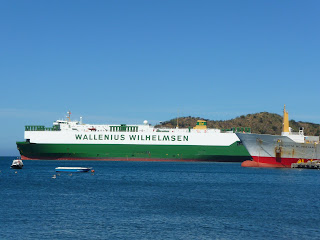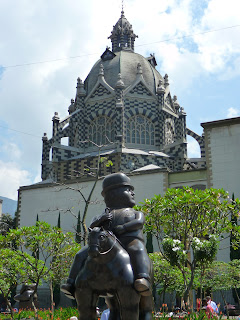--- for English, scroll down ---
Después de ver 3 películas en un vuelo de 11 horas, llegué a Bogotá en la noche del 8 enero. Mi primera impresión fue que el aeropuerto podría haber sido en cualquier ciudad europea, todo estaba muy bien organizado e incluso con las tareas de inmigración y la recogida de mi mochila estaba listo en más o menos 40 minutos. Una hora después del aterrizaje, estaba en el piso de mi amigo Felipe. Impresionante.
Ayer, el 9 enero, empecé a descubrir la ciudad. Solamente una palabra existe para el tamaño de Bogotá: enorme. En el siglo XX, la cuidad estaba creciendo con una rapidez increíble: en el tiempo del cambio del siglo, Bogotá tenía más o menos 100.000 inhabitantes. Hoy tiene más que 8 millones, casi 10 con las afueras incluidas. Fuerte.
Como este día era festivo, me dijeron que no había tanta gente en el centro como normal, aún así los autobuses estaban llenos a un nivel casi insoportable (con estos datos de demografía, no es una gran sorpresa). En Bogotá no hay metro ni tranvía solamente buses. Hay una red de líneas que se llama TransMilenio - estos buses corren en carreras reservadas para ellos, así intentan garantizar que no están bloqueados en los atascos.
 |
| Un autobús TransMilenio en Las Aguas |
Paseando en el barrio La Candelaria (el casco histórico de Bogotá), encontré por casualidad un museo fenomenal. Tiene dos partes: Museo Botero, que es una colección artística y Casa de Moneda que tiene una exposición muy detallada de la historia de moneda en Colombia. Es super interesante, muy grande y totalmente gratuito. Solamente intenté dar una vuelta y finalmente me quedé por lo menos 3 horas...
El pintor principal del Museo Botero es Sr. Botero mísmo. Es un artista nacido en Medellín que tiene un estilo muy particular - todos los carácteres (incluido los objetos) en sus pinturas son muy gordos. Unos ejemplos de su obra:
 |
| Ladrón |
 |
| Caballo |
 |
| Mona Lisa |
El museo también tiene una colección impresionante de pinturas de artistas europeos (Picasso, Klimt, Ernst, Kokoschka, Degas, Monet, Matisse, Toulouse-Lautrec, etc.) y una exposición de obras fotográficas. Es sin duda uno de los mejores museos en que he estado en los ultimos años.
Después del museo, fuimos con Felipe a Monserrate, una iglesia construida en las montañas arriba del Bogotá a una altura de 3152 metros y dedicada a "El Señor Caído". Desde el centro, se puede ir facilmente con un teleférico y la vista es impresionante:
Pues nada, hoy todavía tengo que visitar el Museo del Oro que ayer estaba cerrado y en la noche, me voy a Medellín en autobús.
-------------------------------------------------------------------------------------------------------------
After having seen three films at my 11-hours flight, I arrived to Bogotá in the evening of 8 January. My first impression about the airport was that actually it could have been in any European city, everything was very well organized and even with the immigration duties and the baggage claim, I was ready in more or less 40 minutes. Within an hour after landing, I was at my friend Felipe's place. Impressive.
Yesterday, on 9 January, I started to discover the city. For the size of Bogotá, there's only one proper word: enormous. During the 20th century, the city grew at an incredible pace: at the turn of the century, Bogotá had more or less 100.000 inhabitants. Today it has more than 8 million, almost 10 with the suburbs included. I mean, wow.
As it was a bank holiday, I was told that not as many people were on the streets as usual, still, the buses were often on the brink of falling to pieces due to the immense amount of passengers inside (which is, considering the above demographic data, not a big surprise). In Bogotá, there's no metro nor tram, only buses. There's a bus network called TransMilenio the buses of which can take roads reserved for them - with this the intention is to guarantee that they're not getting blocked in the frequent traffic jams
(see picture above).
While walking around in La Candelaria (the historic old town of Bogotá), I ran into a hilarious museum. It has two parts: Museo Botero, which is an art collection and Casa de Moneda which has a detailed and very informative exhibition about the history of money in Colombia. It was massive, very interesting and completely free. I only intended to drop by when I saw the nice patio from the street and I stayed at least three hours...
The main figure of Museo Botero is Mr. Botero himself. An artist from Medellín, he developed a unique style: all of his characters (objects included) are very fat
(see examples above).
The museum also holds an impressive collection of paintings from famous European artists (Picasso, Klimt, Ernst, Kokoschka, Degas, Monet, Matisse, Toulouse-Lautrec, etc.) and an exhibition of photography artworks. All in all, it is clearly the best museum I have been to in the past years.
After the museum, Felipe and I went to Monserrate, a church built on the mountaintops above Bogotá at the altitude of 3152 meters and dedicated to 'The Fallen Lord', It is very easy to go from the center by cable car and the view is really nice
(see pictures above).
That's it for the time being, today I still have to visit the Museo del Oro which was closed yesterday and in the evening I'll take a night bus to Medellín.










































